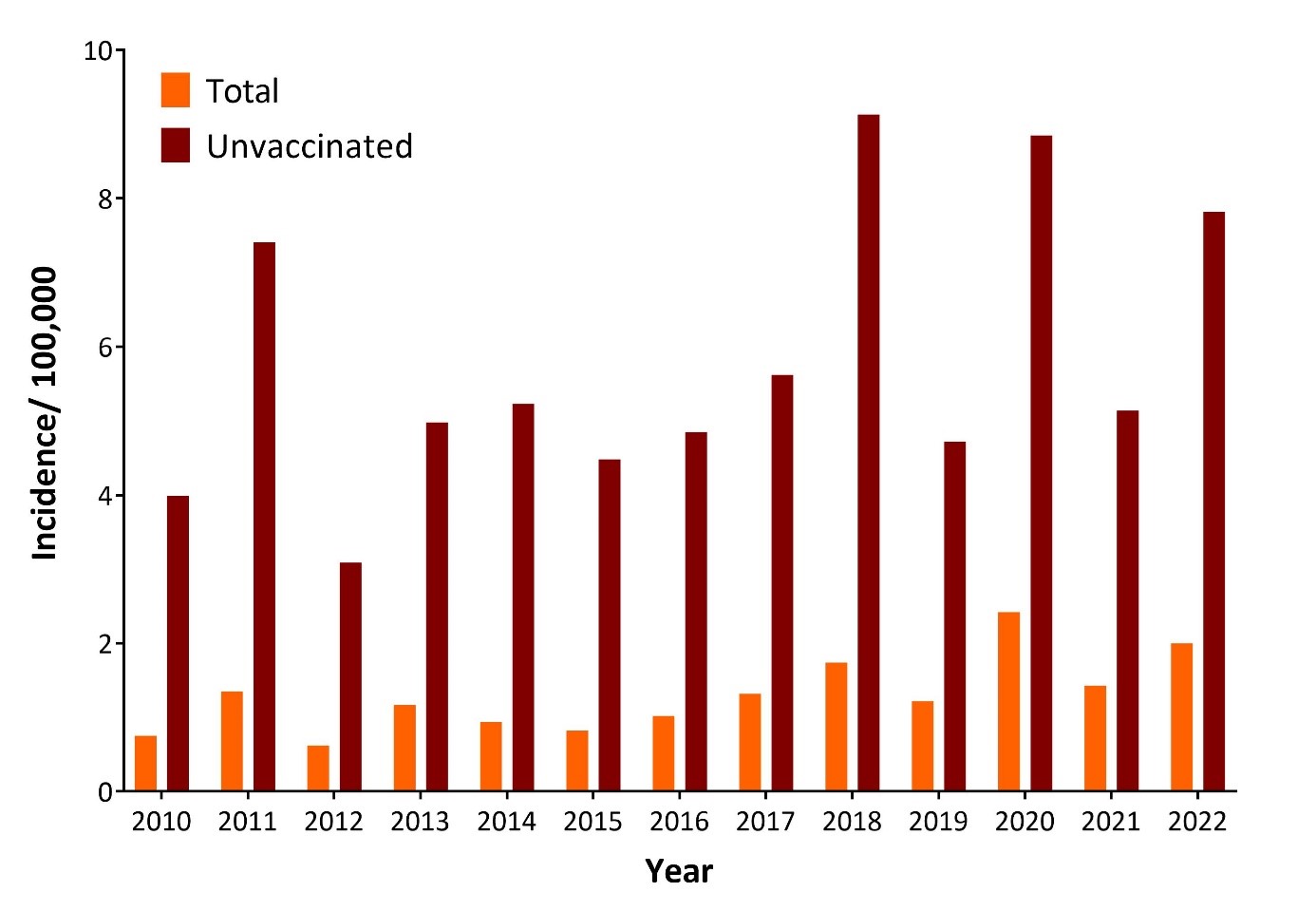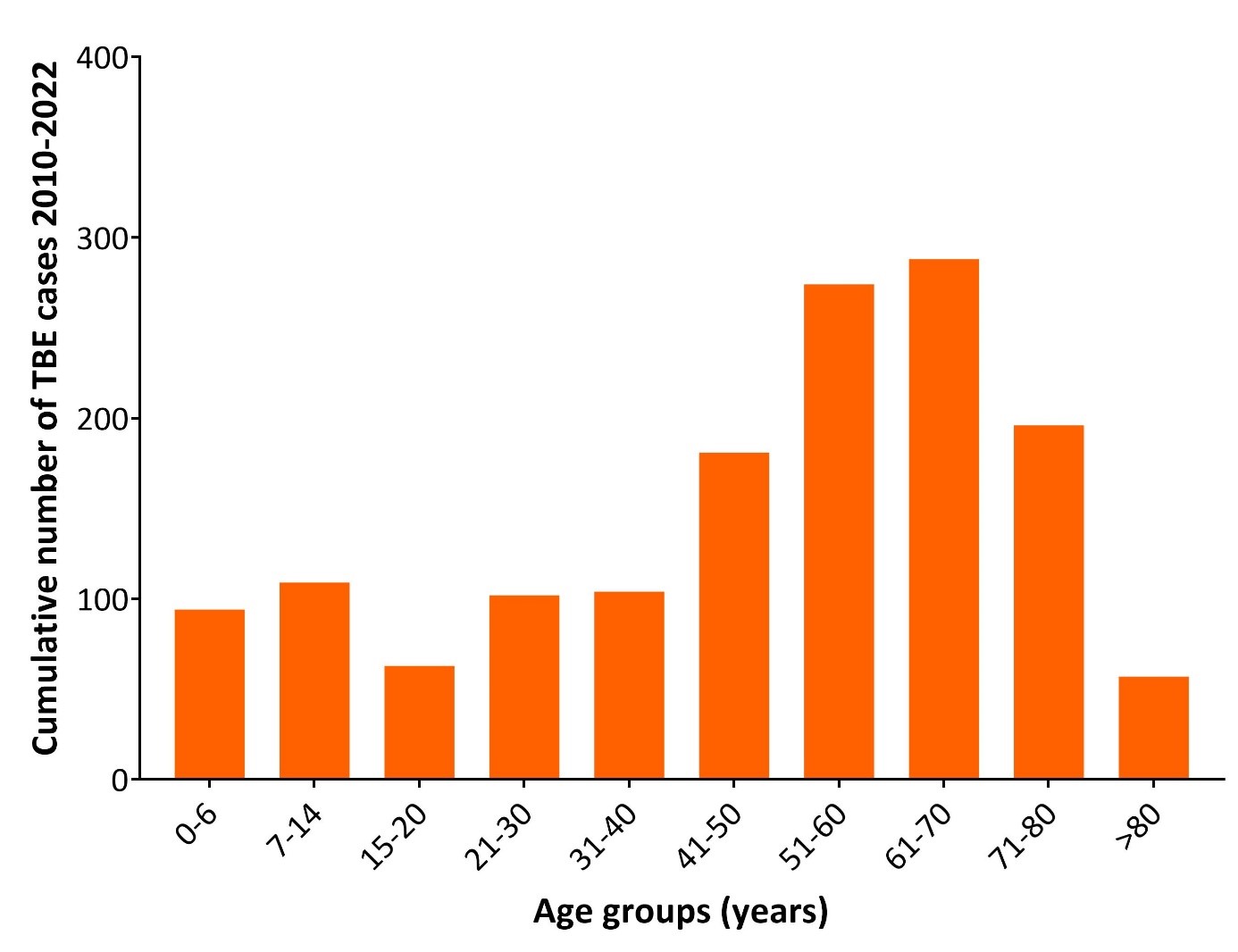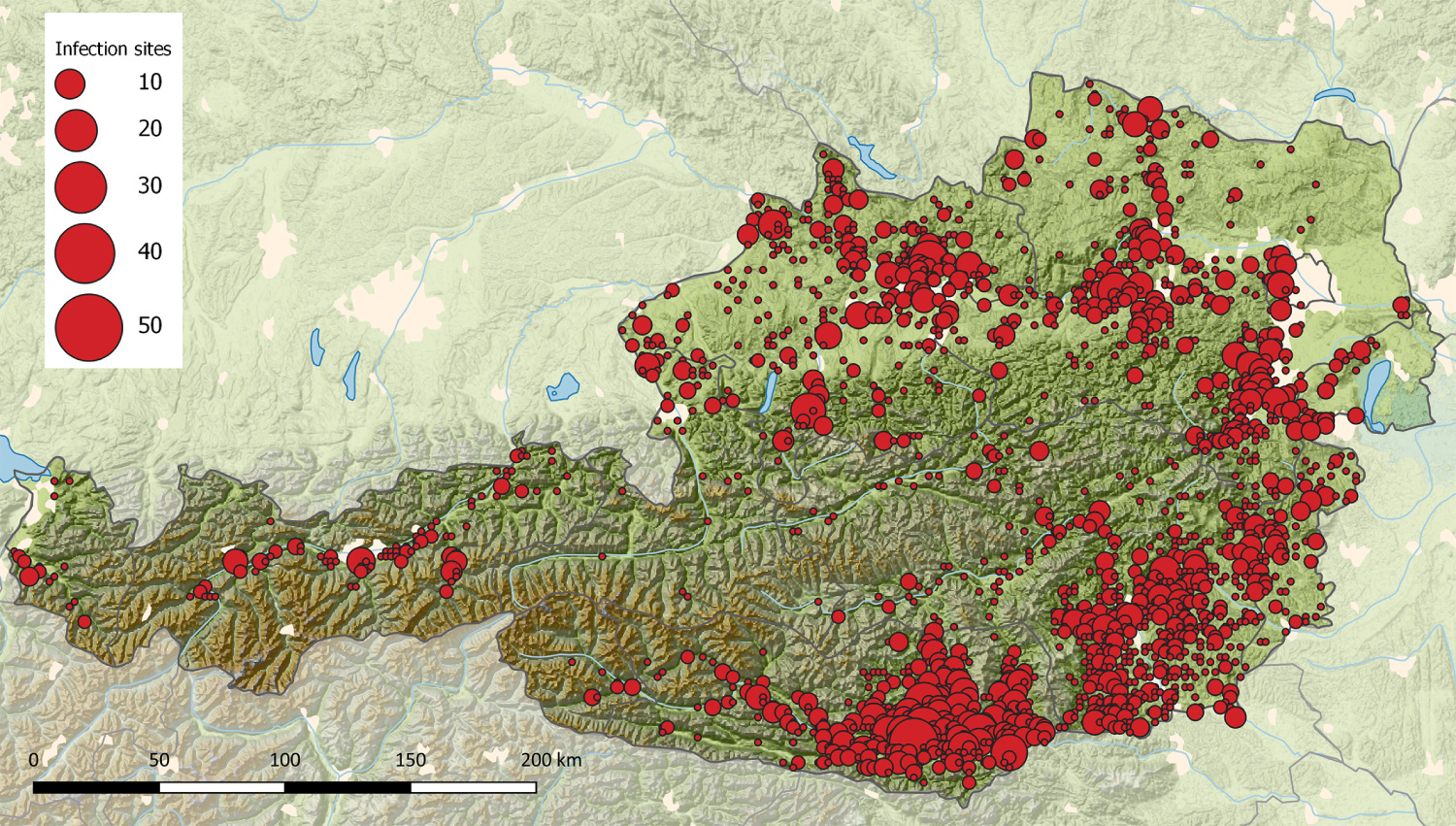Karin Stiasny and Judith H. Aberle
ECDC risk status: endemic
(data as of end 2022)
History and current situation
Since 1972, the documentation of human cases of tick-borne encephalitis (TBE) in Austria has been performed by the Center for Virology, Medical University of Vienna, which acts as the National Reference Laboratory for TBE and other flavivirus infections. Only hospitalized patients with a recent tick-borne encephalitis virus (TBEV) infection confirmed by laboratory diagnosis are counted as cases. Confirmation is usually based on immunoglobulin (Ig) serology (namely enzyme-linked immunosorbent assay [ELISA] for IgM and IgG). However, this confirmation may be supplemented by virus neutralization and polymerase chain reaction (PCR) analyses if needed.
In 2012, TBE became a notifiable disease in Austria as in other countries of the European Union1. The annual incidence rates of TBE in Austria have declined substantially since the 1980s.2 This decline was associated with an increasing rate of vaccination and was not observed in some neighboring countries, for example Czech Republic and Slovenia, where vaccination coverage is much lower than in Austria.2
Incidences of TBE in the total and unvaccinated population in Austria from 2010 to 2021 are shown in Figure 1. Strong annual fluctuations are a characteristic feature of the epidemiology of TBE in Austria, indicating a complex interplay of factors that control viral transmission dynamics in natural hosts and human risk exposure. The age distribution of TBE incidences in Austria is strongly shifted towards older people2 and reveals now a peak in the population 41 to 80 years of age (Figure 2). In addition to virus transmission by tick bites, alimentary infections through the consumption of infected goat cheese have been documented.3 TBE viruses isolated in Austria from ticks and humans were shown through molecular analyses to be members of the European subtype of TBEV (TBEV-Eu)4 [Gerhard Dobler, personal communication].
Mapping of the most likely sites of human infection has been performed by the National Reference Laboratory since 1972 through the use of questionnaires sent to TBE patients with confirmed laboratory diagnosis.5 These data are shown in Figure 3. Although many of the most affected regions remained constant throughout the observation period, new endemic zones – especially in previously unaffected alpine regions in western Austria – were established.5 The first TBE case in the Federal State of Tyrol was documented in 1984 and in Vorarlberg in 2000. In the subsequent years, certain valleys in both states became sites of infection for a substantial number of human TBE cases.5
In parallel, the incidences in the northeastern part of the country (comprising regions with relatively low altitudes) declined,5 suggesting a change to less favorable conditions for virus circulation in this area. In the traditional core TBE zones of Austria, no evidence has been seen for a shift of infection sites to higher altitudes.5
The causes for establishment of new endemic regions in Austria as well as the decline of TBE in other parts of the country are unknown. Surprisingly, these changes are not paralleled by similar alterations in the incidence of borreliosis, which is transmitted by the same ticks as TBEV but remained relatively constant over time in all parts of Austria.6 These data rule out that the substantial geographical shifts of TBE incidence are only caused by changes in tick abundance or human behavior affecting the risk of tick exposure. The discordant epidemiology of TBE and borreliosis in some parts of Austria rather suggests the existence of yet undefined virus-specific factors that control the circulation of TBEV in its animal reservoir and is independent of general factors controlling the proliferation of ticks.
Figure 1: Incidence of TBE in Austria in total and unvaccinated population, 2010–2022

Click the image above to enlarge
Orange columns: TBE incidence in the total population
Magenta columns: TBE incidence in the unvaccinated population (based on patients with a documented status of ‘no vaccination’). Population data were obtained from the Austrian Statistical Office (“Statistik Austria”, https://www.statistik.at/) and vaccination coverage data from “The TBE Book 3rd Edition”.6
| Total | Unvaccinated | |
|---|---|---|
| 2010 | 0.75 | 3.99 |
| 2011 | 1.35 | 7.41 |
| 2012 | 0.62 | 3.09 |
| 2013 | 1.17 | 4.98 |
| 2014 | 0.94 | 5.23 |
| 2015 | 0.82 | 4.48 |
| 2016 | 1.02 | 4.85 |
| 2017 | 1.32 | 5.62 |
| 2018 | 1.74 | 9.13 |
| 2019 | 1.22 | 4.72 |
| 2020 | 2.42 | 8.85 |
| 2021 | 1.43 | 5.14 |
| 2022 | 2.00 | 7.82 |
Figure 2: Age distribution of TBE in Austria, 2010–2022

Click the image above to enlarge
| Age Groups | Cases (n) |
|---|---|
| 0-6 | 94 |
| 7-14 | 109 |
| 15-20 | 63 |
| 21-30 | 102 |
| 31-40 | 104 |
| 41-50 | 181 |
| 51-60 | 274 |
| 61-70 | 288 |
| 71-80 | 196 |
| >80 | 57 |
Figure 3: Sites of TBEV infection in Austria, 1972–2022

Click the image above to enlarge
Infection sites were geocoded and processed for spatial mapping by QGIS (https://www.qgis.org/). Spatially close sites were aggregated using a 2 km raster for Austria, and centroids were calculated for each square. These centroids formed the center of the red circles with diameters proportional to the number of documented infection sites within this area. The base map was built using Natural Earth Data [borders, rivers, lakes, cities; http://www.naturalearthdata.com/] and Global Multi-Resolution Topography (GMRT) synthesis data of the Marine Geoscience Data System (MGDS) [topography; 7, http://www.marine-geo.org/tools/GMRTMapTool/].
Acknowledgments
TBE surveillance was supported by the Austrian Federal Ministry of Social Affairs, Health, Care and Consumer Protection. Mapping of TBEV infection sites was supported by an Investigator-Initiated Research (IIR) grant by Pfizer Corporation Austria Gesellschaft m.b.H. (Epidemiological changes of TBE in Austria).
Authors and Affiliations
Karin Stiasny, Judith H. Aberle
Center for Virology, Medical University of Vienna, 1090 Vienna, Austria
Contact:
karin.stiasny@meduniwien.ac.at
Citation:
Stiasny K., Holzmann H, Santonja I and Heinz F-X. TBE in Austria. In: Dobler G, Erber W, Bröker M, Schmitt HJS, eds. The TBE Book. 6th ed. Singapore: Global Health Press; 2023. doi:10.33442/26613980_12b1-6
References
- Amato-Gauci A, Zeller H. Tick-borne encephalitis joins the diseases under surveillance in the European Union. Euro Surveill. 2012;17(42).
- Heinz FX, Stiasny K, Holzmann H, Grgic-Vitek M, Kriz B, Essl A, et al. Vaccination and tick-borne encephalitis, central Europe. Emerg Infect Dis. 2013;19(1):69-76.
- Holzmann H, Aberle SW, Stiasny K, Werner P, Mischak A, Zainer B, et al. Tick-borne encephalitis from eating goat cheese in a mountain region of Austria. Emerg Infect Dis. 2009;15(10):1671-3.
- Ecker M, Allison SL, Meixner T, Heinz FX. Sequence analysis and genetic classification of tick-borne encephalitis viruses from Europe and Asia. J Gen Virol. 1999;80:179-85.
- Heinz FX, Stiasny K, Holzmann H, Kundi M, Sixl W, Wenk M, et al. Emergence of tick-borne encephalitis in new endemic areas in Austria: 42 years of surveillance. Euro Surveill. 2015;20(13).
- Stiasny K, Santonja I, Holzmann H, Essl A, Stanek G, Kundi M, et al. The Regional Decline and Rise of Tick-Borne Encephalitis Incidence Do Not Correlate with Lyme Borreliosis, Austria, 2005 to 2018. Euro Surveill. 2021;26(35).
- Kunze M, Erber W, Haditsch M. TBE as a matter of public health. Chapter 13. In: Dobler G, Erber W, Bröker M, Schmit HJ, eds. The TBE Book. 4th ed. Global Health Press, Singapore, 2021. doi: 10.33442/26613980_13-4
- Ryan WBF, Carbotte SM, Coplan JO, O’Hara S, Melkonian A, Arko R, et al. Global Multi-Resolution Topography synthesis. Geochemistry, Geophysics, Geosystems. 2009;10(3). Q03014, doi: 10.1029/2008GC002332.